Can Turnitin Detect AI? An Essential Guide for Writers in 2025
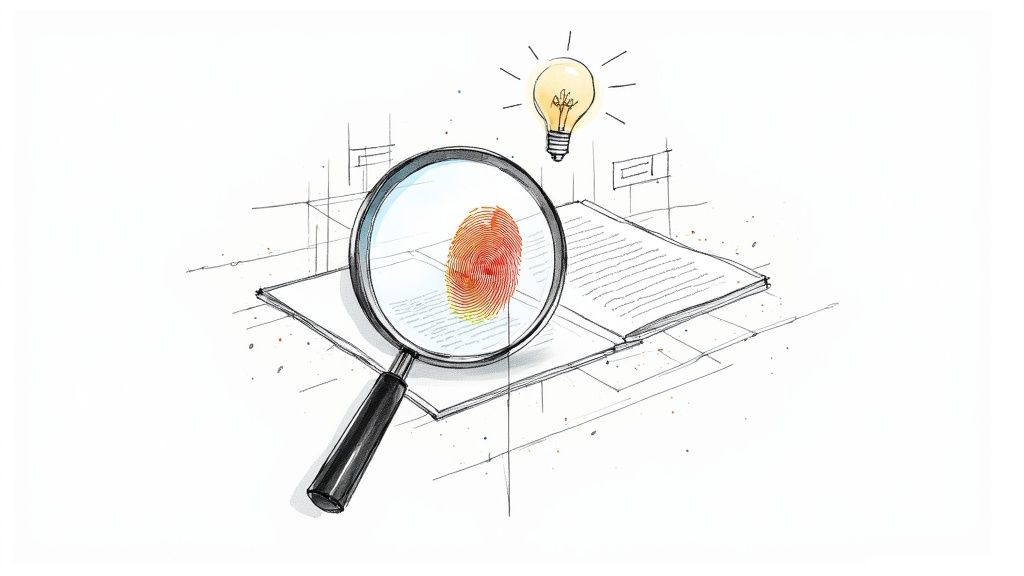
Let's get straight to the point: Yes, Turnitin has a feature designed to detect AI-generated content. But that’s only the beginning of the story. Its accuracy is a subject of ongoing debate, and the results require careful interpretation.
For you as a writer, creator, or student, it's best to think of Turnitin's AI score less as a final verdict and more as a conversation starter—a data point that provides context, not a definitive judgment.
The Short Answer: Yes, but It's Complicated
If you use AI writing tools, you know it can feel like walking a tightrope. You want to leverage their power for brainstorming and drafting, but you also need to maintain your creative voice and academic integrity. That's why understanding Turnitin's capabilities is so crucial.
Turnitin's detector now analyzes subtle linguistic patterns that can distinguish between human and machine writing. This infographic breaks down what its AI score really means.
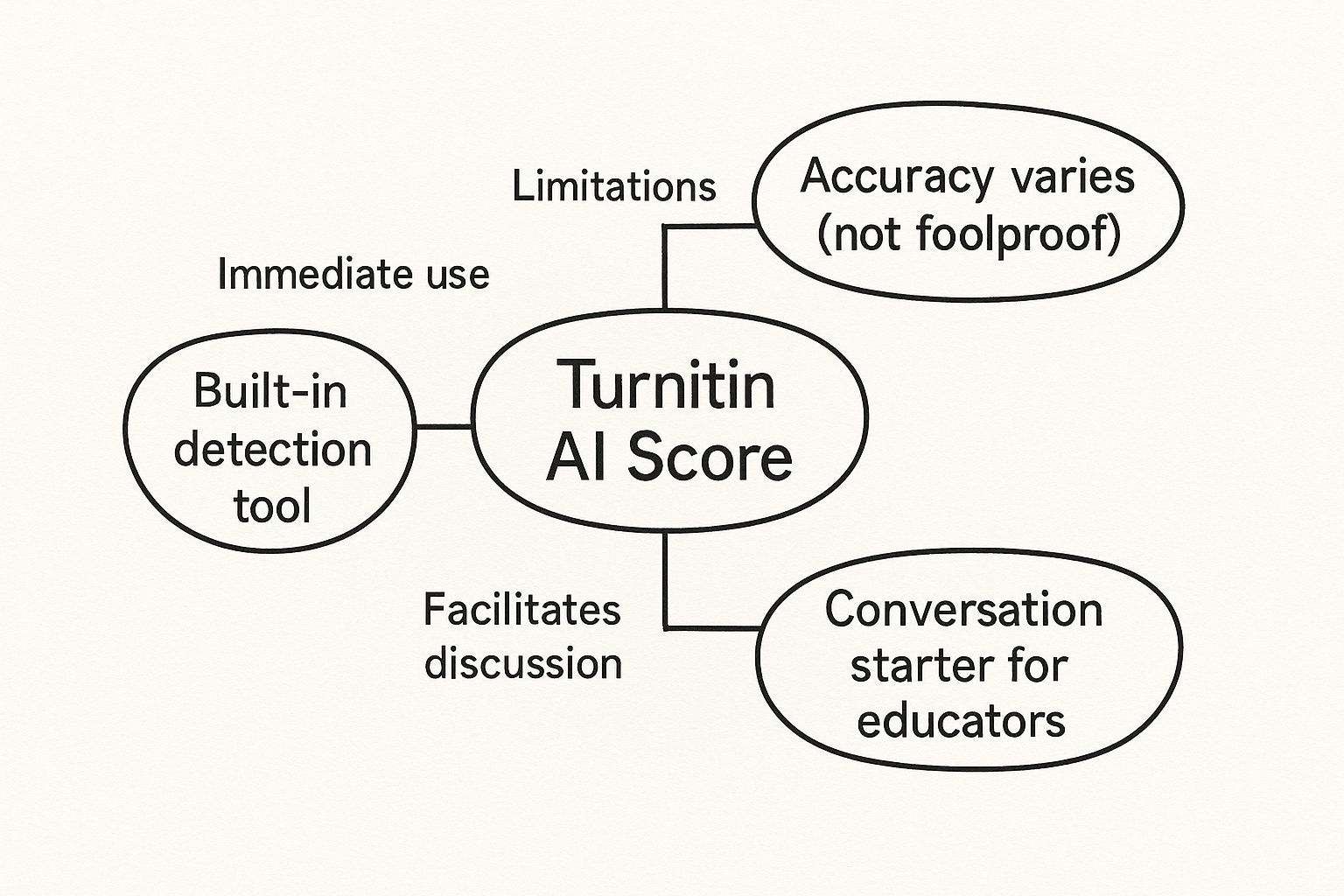
As you can see, the score is a nuanced indicator, not a simple "AI" or "human" label. It's designed to open a discussion, not end one.
A Closer Look at the Accuracy Claims
When Turnitin launched its AI detector, it claimed a 98% accuracy rate. The company also reported a false positive rate of less than 1% for papers with at least 20% AI writing.
However, independent research from academic institutions paints a more complex picture. For instance, one study found Turnitin correctly identified 77% of fully AI-generated texts. This highlights a noticeable gap and an ongoing debate over Turnitin's AI detection accuracy in 2025.
Here’s a quick summary of its AI detection capabilities.
Turnitin AI Detection At a Glance
| Feature | What It Means for You |
|---|---|
| Linguistic Analysis | The tool looks beyond plagiarism, analyzing word choice and sentence complexity to identify common AI patterns. |
| AI Score Percentage | You get a percentage, not a simple yes/no. This score estimates how much of the text appears AI-generated. |
| Claimed Accuracy | Turnitin advertises a 98% accuracy rate, but this has been contested by several independent studies. |
| False Positive Rate | The official claim is <1% for false positives, but real-world scenarios show this can be higher, especially with mixed human-AI text. |
| Focus on Guidance | Turnitin encourages educators to use the score as a starting point for discussion, not as standalone proof of misconduct. |
Ultimately, the AI score should be treated as just one piece of evidence, not the final word.
The key takeaway is this: While Turnitin can detect AI, its effectiveness isn't absolute. You and your instructors should treat the score as a data point, not a definitive conclusion.
At PureWrite, we champion the ethical use of AI as a powerful assistant. The goal isn't to "beat" a detector; it's to produce high-quality, authentic work that is truly your own. When you understand how these tools work, you can use AI responsibly to enhance your creativity, not replace it.
How Does Turnitin Actually Detect AI Writing?
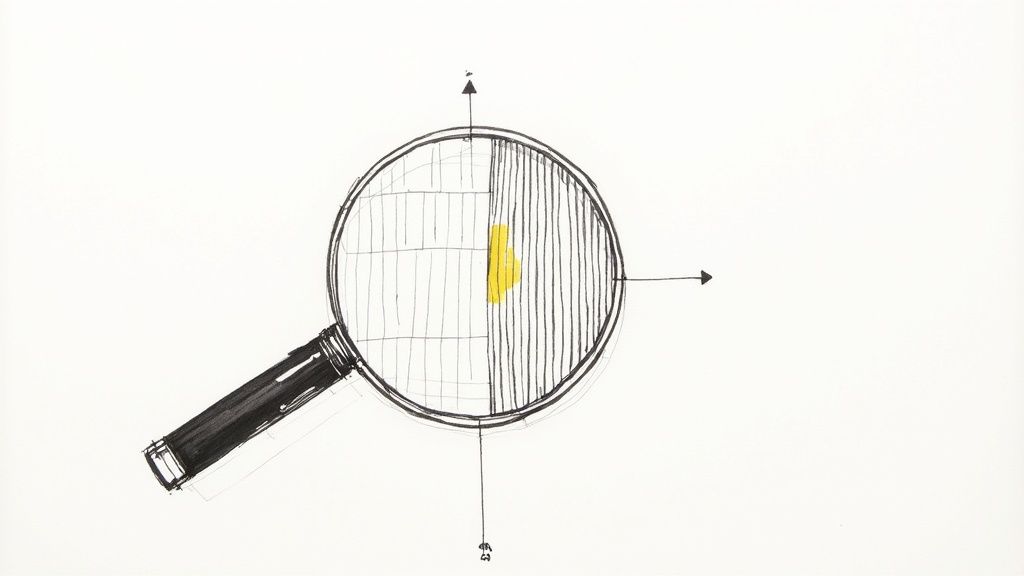
So, how does Turnitin identify AI-generated text? The process goes far beyond simple plagiarism checks. The real analysis happens at a deeper level, examining the linguistic DNA of the writing itself.
Think of it like an art expert spotting a forgery. They analyze the brushstrokes and stylistic habits of the artist. Turnitin's AI detector does the same with words, scrutinizing the statistical patterns that reveal an AI's non-human touch.
The Giveaways: Perplexity and Burstiness
Two of the biggest indicators of AI writing are concepts called perplexity and burstiness. Though they sound technical, the ideas behind them are quite straightforward.
Perplexity measures how predictable your writing is. AI models are trained to choose the most statistically likely next word, which makes their writing smooth but often bland.
Burstiness relates to rhythm and flow. Human writing is naturally varied; we mix short, punchy sentences with longer, more descriptive ones. AI models often struggle with this, producing sentences of uniform length.
For example, a human might write, "The project failed. After months of work, the team's final effort just wasn't enough." An AI, aiming for predictability, might produce something far more uniform. This lack of variation is a major red flag for detectors.
The Trouble with "Too Perfect"
This brings us to a core challenge with AI-generated text: it's often too perfect. The grammar is flawless, the structure is consistent, and the word choice is safe. This robotic perfection is a massive indicator for detection systems.
Turnitin's system is built to find writing that lacks the messy, beautiful fingerprints of human thought. It zeroes in on text that feels too predictable and rhythmically flat.
This is why simply swapping a few words won't fool it. Such superficial changes don't alter the underlying statistical patterns—the burstiness and perplexity—that the AI detector analyzes. To truly humanize AI-assisted writing, you need to reshape its structure and flow.
If you're looking to do just that, our guide on using an AI text humanizer offers practical steps. We built PureWrite to specifically address these core linguistic tells, helping you inject the natural variety that makes writing feel genuinely human.
So, you’ve received an AI score from Turnitin. Seeing that percentage can be unnerving, but before you panic, it's crucial to understand what that number means. Think of it as a data point that requires human interpretation.
The score simply indicates how much of your text follows patterns common in AI-generated writing. To understand what it's telling you, let's discuss two key concepts: false positives and false negatives.
https://www.youtube.com/embed/JCSWT_cqOx8
Understanding False Positives and Negatives
A false positive is a major concern—it's when your 100% human-written text gets flagged as AI-generated. A false negative is when AI-written content slips past the detector.
Turnitin has stated that its system is designed to minimize false positives, knowing that a wrongful accusation is a serious matter. This cautious approach means their system is more likely to have false negatives, allowing some AI-generated text to go undetected.
The bottom line is this: Turnitin would rather miss a few instances of AI use than falsely accuse an innocent student. The score is a signal for an instructor to take a closer look, not a final judgment.
This approach acknowledges the reality of modern writing. Many writers—from students to professionals—use AI for a first draft before blending in their own edits. This hybrid writing makes it incredibly difficult for any detector to make a definitive call.
How Mixed Writing Affects Accuracy
When a text is a mix of human and AI writing, things get even murkier. Research shows that when content was part AI and part human, or when AI text was edited to sound more human, detection rates dropped significantly.
One study found that Turnitin only flagged 63% of disguised AI texts. For hybrid content, the accuracy ranged between 23% and 57%. This reinforces the trade-off Turnitin made: to keep false accusations low, they accept that around 15% of AI-written text might go undetected.
This is why using AI ethically is so important. There's a world of difference between using AI to brainstorm ideas and submitting an unedited draft. For more guidance on this, check out our article on how to improve academic writing.
That’s where we can help. PureWrite is designed to help you bridge that gap. Our tool refines the robotic, predictable patterns that AI detectors are trained to spot, adding the natural flow and variation that makes writing sound genuinely human. Ready to see the difference? Try PureWrite for free.
How to Use AI Writing Tools Ethically and Effectively
Understanding how Turnitin’s AI detector works is only half the battle. The other half is using that knowledge to write responsibly. Instead of trying to "beat" the system, you can learn to use AI as an ethical assistant that enhances your own abilities.
The key is to treat AI as your starting block, not the finish line. It's a fantastic tool for overcoming writer's block, brainstorming ideas, or creating a solid outline. For non-native English speakers, it can also be a game-changer for polishing grammar and syntax.
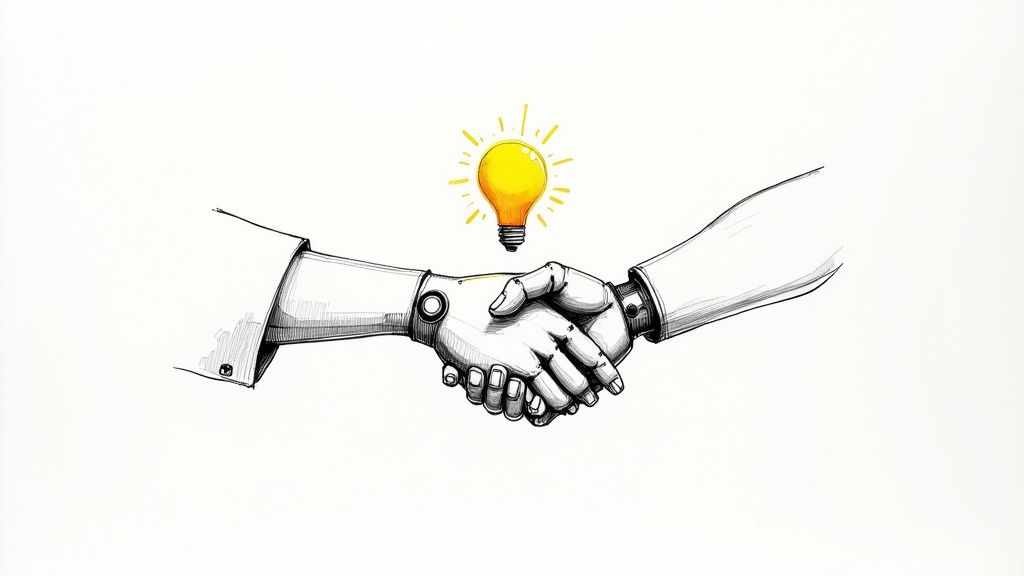
This is the approach that platforms like Turnitin advocate for—using technology to support learning, not replace it. The goal is to foster an honest academic environment where AI's role is acknowledged and managed ethically.
A Framework for Authentic AI-Assisted Writing
To create work that is truly your own, you need a clear process. This isn't just about avoiding a detection flag; it's about owning what you produce. Your unique voice and personal insights are what give your writing its value.
Here’s a practical framework for ethical AI use:
Brainstorm and Outline: Use AI to kickstart your thinking. Ask it to generate ideas, explore different angles on a topic, or organize your thoughts into a logical outline.
Generate a "Clay" Draft: Let the AI produce a rough first draft. Think of this as unformed clay—it has shape, but the real artistry comes from what you do next.
Inject Your Voice: This is the most crucial step. Rewrite entire sections in your own words. Weave in personal anecdotes, your own analysis, and critical perspectives that an AI cannot replicate. With 59% of students already using AI, that human touch is what will make your work stand out.
Fact-Check Rigorously: Never forget that AI models can "hallucinate" and present false information as fact. You are the final editor. Verify every statistic, fact, and source.
This process transforms generic text into something you can proudly call your own. If you'd like a tool to help with this, give PureWrite a try.
The objective isn't just to write something that bypasses a detector. It's to produce work that genuinely reflects your thinking and expertise, with AI acting as a helpful co-pilot.
This principle is the foundation of PureWrite. We built our tool to augment your creativity, not automate it. You can bring us your AI-generated "clay," and we'll help you mold it into a polished piece of writing that is undeniably human and authentically yours.
Common Myths About AI Detection Debunked
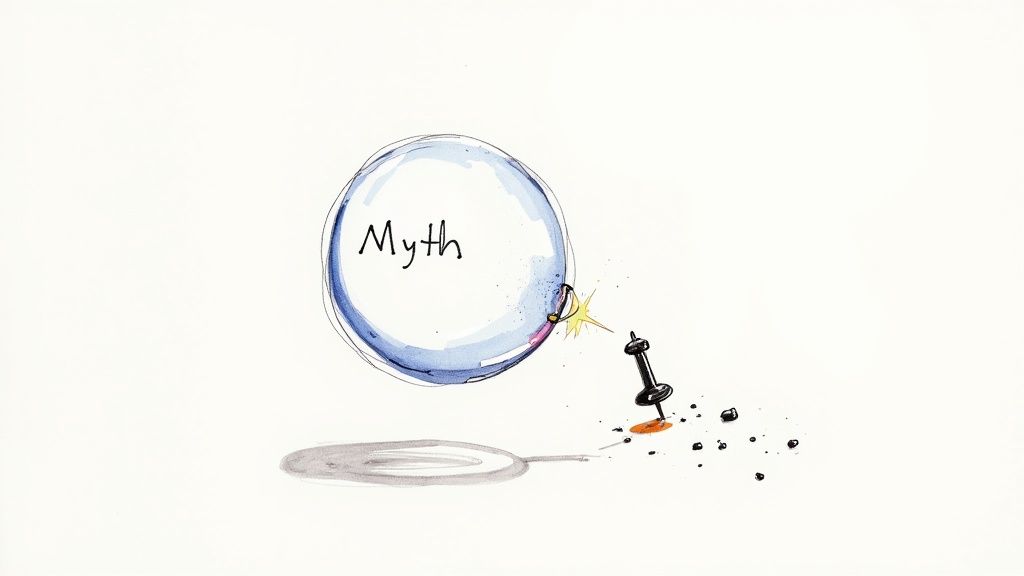
A lot of misinformation surrounds Turnitin’s AI detection, causing unnecessary stress for content creators and students. Let's clear up a few common myths with facts.
One popular myth is that using a grammar checker will get your paper flagged. This is not true. Tools like Grammarly check your text for correctness and clarity, which is completely different from what generative AI models do. Turnitin looks for the statistical fingerprints of AI generation, not perfect grammar.
Misconceptions About Bypassing Detectors
Another myth is that you can easily fool the system with a few quick edits. Many people think running text through a basic paraphrasing tool or swapping synonyms is enough to appear human.
Unfortunately, it’s not that simple. Those superficial changes don't alter the text’s underlying linguistic DNA. AI-generated writing often has a predictable structure and a flat rhythm, which is what detectors are built to spot. You can learn more in our guide on how to rewrite AI text to human.
Key Takeaway: AI detectors analyze deep structural and statistical patterns, which makes them very hard to fool with simple word swaps or other surface-level tricks.
Educational institutions are investing heavily in this technology. The California State University system recently spent an additional $163,000 on its Turnitin license to enhance AI detection. As critics have noted, the risk is that these systems may sometimes flag writing that simply sounds like AI, potentially affecting honest students. You can read more about this trend and its implications.
At PureWrite, our focus is on helping you ethically refine your drafts. The goal isn't to "trick" a system but to help you transform an AI-assisted starting point into a polished, authentic piece of work that is genuinely yours.
A Few Lingering Questions About Turnitin and AI
Let's wrap up by tackling some of the most common questions people have about Turnitin's AI detection. Getting these answers straight should give you a clearer picture of what you're dealing with.
Can Turnitin Really Detect Today's Best AI Models?
In a word, yes. Turnitin's algorithm isn't trained on a single AI like ChatGPT. It's built to recognize the linguistic fingerprints left by a wide range of models, including powerful ones like GPT-4 and Google's Gemini.
Even though a new AI might write more sophisticated prose, it still "thinks" in a statistically predictable way. It's those subtle, mathematical patterns in word choice and sentence structure that the detector is trained to identify.
What's a "Safe" AI Score on a Turnitin Report?
This is a common question, but there's no magic number. An "acceptable" score is determined by the instructor or institutional policy. However, Turnitin itself has indicated it has low confidence in flagging anything under 20%.
Most educators use the score as a conversation starter, not a guilty verdict. A very low score will likely be ignored, while a high percentage will probably trigger a closer review.
The AI score is just one piece of the puzzle. It’s designed to support a teacher’s professional judgment, giving them another data point to consider alongside their knowledge of a student's writing style.
How Does PureWrite Fit Into This?
This is where we come in. PureWrite is designed to help you bridge the gap between a raw AI draft and a piece of writing that sounds genuinely human. Our tool does more than just swap words; it reworks sentence structures and injects a natural, human rhythm into the text.
This process is specifically engineered to disrupt the very linguistic patterns that AI detectors look for.
A great workflow is to use AI for the initial grunt work—like creating an outline—and then bring it to our platform for a deep polish. If you also want to strengthen your own writing skills, our guide on how to improve English writing skills is packed with actionable tips. But remember, your final edit is always the most important step.
Ready to turn those AI-assisted drafts into polished, authentic work? PureWrite gives you the tools to refine your content to the highest standard, so you can submit your work with complete confidence. Try PureWrite today and see what a human touch can do.